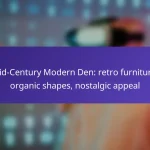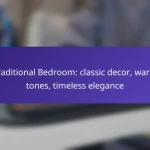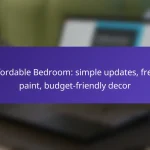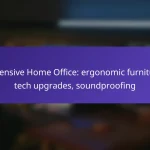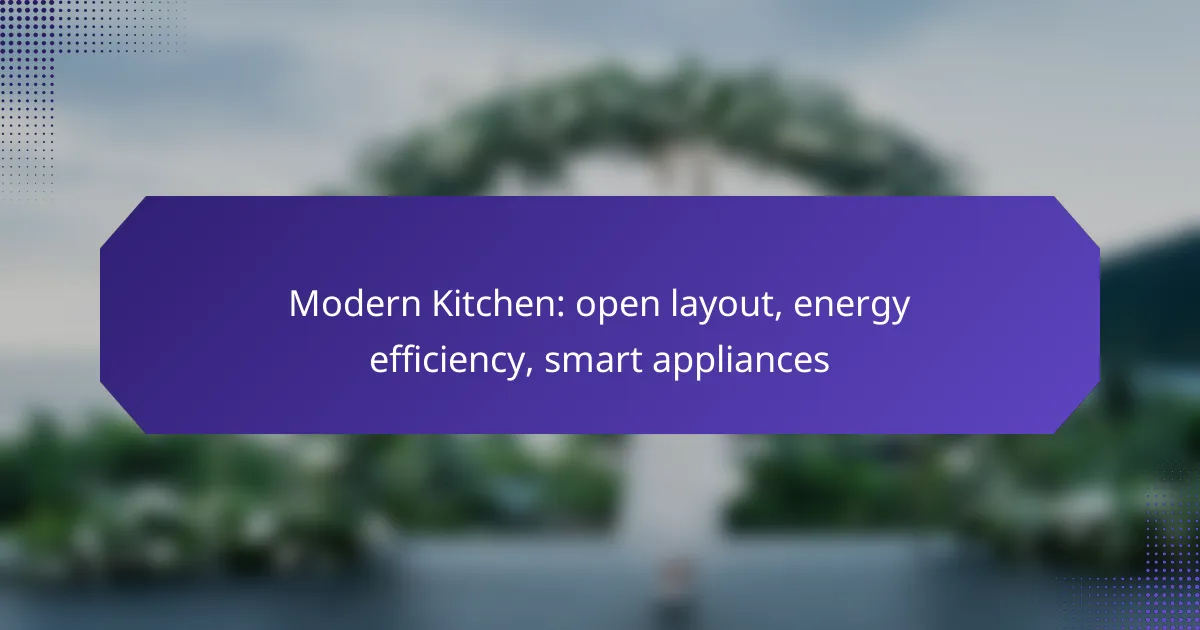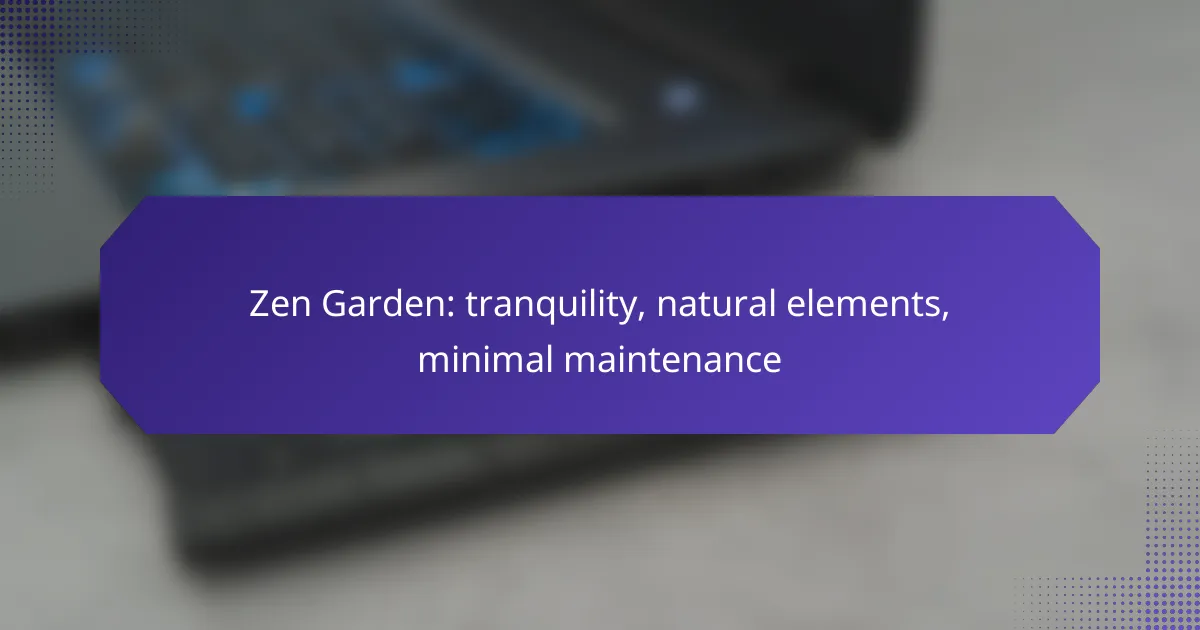Modern kitchens are designed with an open layout that promotes spaciousness and functionality, creating a seamless connection between cooking and living areas. By incorporating energy-efficient appliances and smart technology, these kitchens not only enhance convenience but also contribute to sustainability and reduced utility costs. Embracing these elements allows homeowners to enjoy a stylish and efficient culinary space.

What are the best open layout designs for modern kitchens in Canada?
The best open layout designs for modern kitchens in Canada emphasize spaciousness, functionality, and a seamless flow between cooking and living areas. Popular designs include open-concept layouts, U-shaped kitchens, island configurations, and galley-style kitchens, each offering unique advantages for maximizing space and efficiency.
Open-concept layouts
Open-concept layouts are characterized by a lack of walls separating the kitchen from adjacent living spaces, creating a unified area for cooking and socializing. This design fosters interaction among family members and guests, making it ideal for entertaining.
When considering an open-concept kitchen, focus on integrating design elements like consistent flooring and color schemes to enhance visual continuity. Ensure that adequate lighting is provided, as these spaces can often feel darker without proper illumination.
U-shaped kitchen designs
U-shaped kitchen designs feature three walls of cabinetry and appliances, forming a U-shape that maximizes storage and counter space. This layout is particularly effective for smaller homes, allowing for efficient workflow and easy access to all cooking zones.
To optimize a U-shaped kitchen, consider incorporating an island or a peninsula for additional workspace. Ensure that there is enough clearance between the walls and the island to facilitate movement, ideally maintaining a distance of at least 1 meter.
Island configurations
Island configurations are popular for their versatility and functionality, serving as a central hub for food preparation, dining, and socializing. An island can include features such as a sink, cooktop, or additional storage, enhancing the kitchen’s efficiency.
When designing an island, ensure it complements the overall kitchen layout and allows for sufficient space around it—ideally, at least 1 meter on all sides. Consider using contrasting materials or colors to make the island a focal point in the kitchen.
Galley-style kitchens
Galley-style kitchens consist of two parallel countertops with a walkway in between, making them efficient for cooking and meal preparation. This design is particularly suited for narrower spaces, maximizing functionality without sacrificing style.
To enhance a galley kitchen, focus on vertical storage solutions, such as shelves and cabinets that reach the ceiling. Ensure that the layout allows for easy movement between the two sides, ideally maintaining a walkway of at least 1 meter for comfort and safety.

How can energy efficiency be achieved in modern kitchens?
Energy efficiency in modern kitchens can be achieved through the use of advanced appliances, effective lighting, and proper insulation. By integrating these elements, homeowners can significantly reduce energy consumption and lower utility bills.
Energy-efficient appliances
Energy-efficient appliances are designed to use less electricity or water compared to standard models. Look for appliances with the ENERGY STAR label, which indicates compliance with energy efficiency guidelines set by the U.S. Environmental Protection Agency or equivalent local standards.
When selecting appliances, consider options like induction cooktops, which heat food faster and use less energy, or smart refrigerators that optimize energy use based on your habits. Investing in these appliances may have a higher upfront cost but can lead to substantial savings over time.
LED lighting solutions
LED lighting is a key component of energy efficiency in modern kitchens. These bulbs consume significantly less energy than traditional incandescent bulbs and have a longer lifespan, reducing replacement costs and waste.
To maximize efficiency, replace all overhead and task lighting with LED fixtures. Consider dimmable options to adjust brightness according to the time of day or activity, further saving energy. A well-lit kitchen can enhance functionality while minimizing energy use.
Insulation and ventilation improvements
Proper insulation and ventilation are crucial for maintaining energy efficiency in the kitchen. Insulation helps keep the space warm in winter and cool in summer, reducing the need for heating and cooling systems.
Check for gaps around windows and doors, and consider upgrading to double-glazed windows for better insulation. Additionally, ensure that your kitchen has adequate ventilation to prevent excess humidity, which can lead to mold and energy loss. Installing energy-efficient exhaust fans can help maintain air quality while minimizing energy consumption.

What smart appliances enhance modern kitchen functionality?
Smart appliances significantly improve modern kitchen functionality by integrating technology that simplifies tasks, enhances energy efficiency, and provides remote control options. These devices not only save time but also contribute to a more sustainable kitchen environment.
Smart refrigerators
Smart refrigerators offer features like touch screens, internal cameras, and Wi-Fi connectivity, allowing users to manage groceries and meal planning more effectively. For instance, you can check the contents of your fridge remotely and receive alerts when items are running low.
When choosing a smart refrigerator, consider energy efficiency ratings and the size that fits your kitchen layout. Look for models that provide energy-saving modes, which can help reduce your electricity bill over time.
Wi-Fi-enabled ovens
Wi-Fi-enabled ovens allow for remote preheating, cooking monitoring, and recipe integration, making meal preparation more convenient. You can adjust cooking times and temperatures from your smartphone, ensuring that your dishes are cooked perfectly even if you’re not in the kitchen.
While selecting a Wi-Fi-enabled oven, check for compatibility with your home network and any additional features like self-cleaning or smart cooking modes. These can enhance usability and save time on maintenance.
Smart dishwashers
Smart dishwashers come equipped with sensors that optimize water and energy usage based on the load size and soil level. They can be controlled remotely, allowing you to start or pause cycles from your mobile device.
When evaluating smart dishwashers, consider their noise levels, energy efficiency ratings, and available wash cycles. Look for models that offer eco-friendly settings to minimize water and energy consumption, which can lead to lower utility costs.

What are the costs associated with modern kitchen renovations in Canada?
The costs of modern kitchen renovations in Canada can vary widely based on factors like size, materials, and the extent of upgrades. Homeowners typically spend anywhere from CAD 15,000 to CAD 50,000 or more, depending on their specific needs and choices.
Average renovation costs
On average, a kitchen renovation in Canada can range from CAD 15,000 for a basic remodel to over CAD 50,000 for a high-end upgrade. Key factors influencing costs include the size of the kitchen, the quality of materials, and the complexity of the design. For a mid-range renovation, expect to budget around CAD 30,000 to CAD 40,000.
Consider obtaining multiple quotes from contractors to ensure competitive pricing. Be aware that unexpected expenses can arise, so it’s wise to set aside an additional 10-20% of your budget for contingencies.
Cost of energy-efficient appliances
Energy-efficient appliances can significantly impact your renovation budget, with costs typically ranging from CAD 1,000 to CAD 5,000 each. While these appliances may have a higher upfront cost, they can lead to long-term savings on energy bills and may qualify for rebates or incentives in Canada.
When selecting appliances, look for the ENERGY STAR label, which indicates compliance with energy efficiency standards. This can help you make informed choices that align with both your budget and environmental goals.
Budgeting for smart technology
Incorporating smart technology into your kitchen renovation can enhance convenience and efficiency, with costs ranging from CAD 500 to CAD 3,000 depending on the systems chosen. Smart appliances, lighting, and home automation systems can be integrated to create a cohesive smart kitchen experience.
When budgeting, consider the potential for increased home value and energy savings. Prioritize essential smart features that align with your lifestyle, and research available products to find the best fit for your renovation goals.
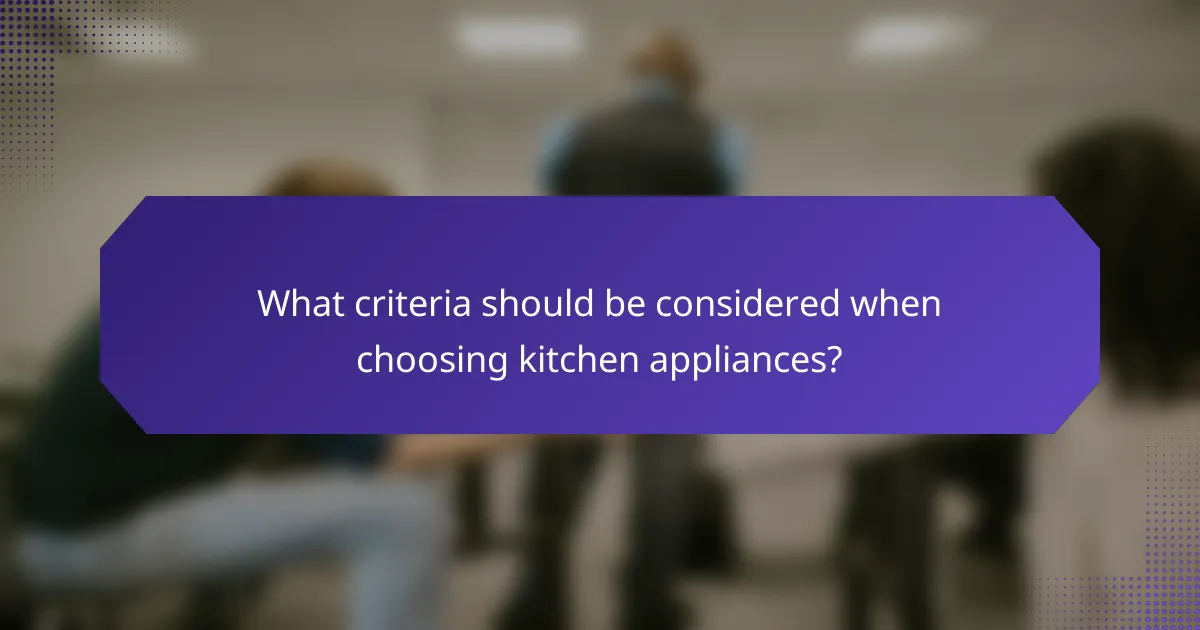
What criteria should be considered when choosing kitchen appliances?
When selecting kitchen appliances, consider energy efficiency, smart features, and brand reliability. These factors will help ensure that your appliances meet your cooking needs while being cost-effective and durable.
Energy ratings
Energy ratings indicate how efficiently an appliance uses electricity, which can significantly impact your utility bills. Look for appliances with high ratings, such as those labeled A+++ in Europe or ENERGY STAR certified in the U.S., as they typically consume less energy.
When comparing appliances, check the estimated annual energy consumption, which is often displayed on the energy label. For example, a refrigerator with an annual consumption of 200 kWh is generally more efficient than one consuming 400 kWh.
Smart features
Smart features enhance convenience and efficiency in the kitchen. Appliances with Wi-Fi connectivity allow you to control settings remotely, receive alerts, and even integrate with home automation systems.
Consider features like programmable settings, energy monitoring, and compatibility with voice assistants. For instance, a smart oven can preheat while you’re away, saving you time and energy when you return home.
Brand reliability
Brand reliability is crucial for ensuring that your appliances last and perform well. Research customer reviews and ratings to gauge the performance and durability of different brands.
Look for brands with a strong warranty and customer service reputation. A reliable appliance may cost more upfront but can save you money in repairs and replacements over time.

What are the latest trends in modern kitchen design?
Modern kitchen design trends focus on open layouts, energy efficiency, and smart appliances. These elements create functional, stylish spaces that enhance cooking and social interactions.
Open Layouts
Open layouts are increasingly popular in modern kitchens, promoting a seamless flow between cooking, dining, and living areas. This design choice encourages social interaction, making it easier for families and guests to gather.
When considering an open layout, think about how to integrate the kitchen with adjacent spaces. Use consistent flooring and color schemes to create a cohesive look. Additionally, consider the placement of islands or breakfast bars to enhance usability.
Energy Efficiency
Energy efficiency is a key trend in modern kitchen design, driven by rising energy costs and environmental concerns. Incorporating energy-efficient appliances and fixtures can significantly reduce energy consumption.
Look for appliances with high Energy Star ratings, which indicate better energy performance. Simple changes, like installing LED lighting and low-flow faucets, can also contribute to overall energy savings. Aim for a kitchen that minimizes waste and maximizes efficiency.
Smart Appliances
Smart appliances are transforming modern kitchens by offering convenience and enhanced functionality. These devices can be controlled remotely and often feature energy-saving settings.
Examples include smart refrigerators that track inventory and suggest recipes, or ovens that can be preheated from your smartphone. When selecting smart appliances, consider compatibility with your home network and ease of use. Prioritize devices that offer practical features that align with your cooking habits.

